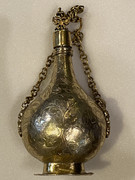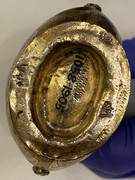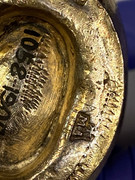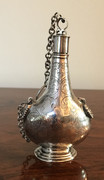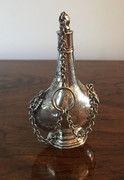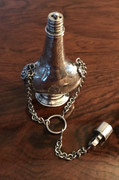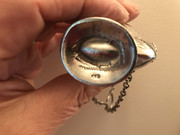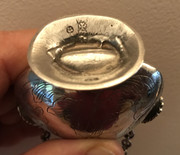Hello,
Firstly I need to thank Alaine Apap Bologna for her collaboration in formulating this response, she has a great depth of knowledge of Maltese silver and I have suggested that she joins our forum as I believe her input would be invaluable and we could all learn from her.
Now to the mark in question:
The mark on the flask is the mint mark which was introduced in the Perellos period (1697-1720) and continued to be used by the Master of the Mint or his assistant of the time with each period having a different shape for each Magistracy. This particular mint mark was introduced by Michele Arcangelo Pianta in 1715, who then became Consul for Silversmiths, with the shape of a circle with indents and either four, five or six pellets. The mark on this flask is a circle with indents and four pellets. I attach a better photo to the one I posted earlier.
The mint mark with four, five or six pellets but in a circle is found on items in the 1750s and represents :
four pellets: Maltese standard alloy (circa 835/1000)
five pellets: Roman standard alloy (circa 877/1000)
six pellets: French standard alloy. (circa 930/1000)
Moving on to the assay mark the one on this flask is that indicated in red on the earlier post and is a variant of the ones used in the Manoel de Vilhena period (1722-1736). There are a few of these, but essentially these have an outline around the "MA, Maltese Cross above”-the punches are mostly asymmetrical. The ones used in the Perellos period (1697-1720), as the V&A flask, are comparable to the one illustrated adjacent to it being symmetrical or "a keyhole punch”.
G.M. Pinto (1741-1773), as ambitious as he was, decided to adopt a crown and therefore the assay mark became MA, Mse. Cross and coronet above, in an outlined punch. His successor, G.M. Ximenes de Texada (1773-1775) kept the same style (he didn’t have much time to dedicate to the Mint as Pinto left him an enormous task in improving finances).
G.M. Emanuel de Rohan (1775-1797) however had the marking system revised, with numerous mint marks added. The assay marks used during his Magistracy were ‘F crown above’ for French standard, ‘R crown above' for Roman standard and 'M crown above’ for Maltese standard. All three were closed crowns. These marks were also used during the short Magistracy of G.M. Hompesch.
There is no proof that any marks were used on silver during the French Occupation. Napoleon and Vaubois were too busy melting the huge amount of gold and silver they looted. The only marks found are on silver ingots.
And finally the maker’s mark AP in oblong: Andrea Pace. His mark was registered in 1715, with some twenty silversmiths. This was the first year that the maker’s mark was imposed. Most of the silversmiths in that year had long before practised their craft and were advanced in age. Alaine is of the opinion that is was Michele Arcangelo Pianta, Master of the Mint in 1715 and Vincenzo Menville (of French lineage from Toulouse), Consul for Silversmiths in 1715 who made it legal. Both these silversmiths applied their maker’s mark a few years beforehand, and perhaps, also Andrea Pace.
This is the essence of Alaine's response and I hope I have captured everything correctly.
I said that I would post images of the flask in the V&A who have now kindly forwarded photos of the item. The V&A website has also been updated with these pictures.
Regards,
Trevor

